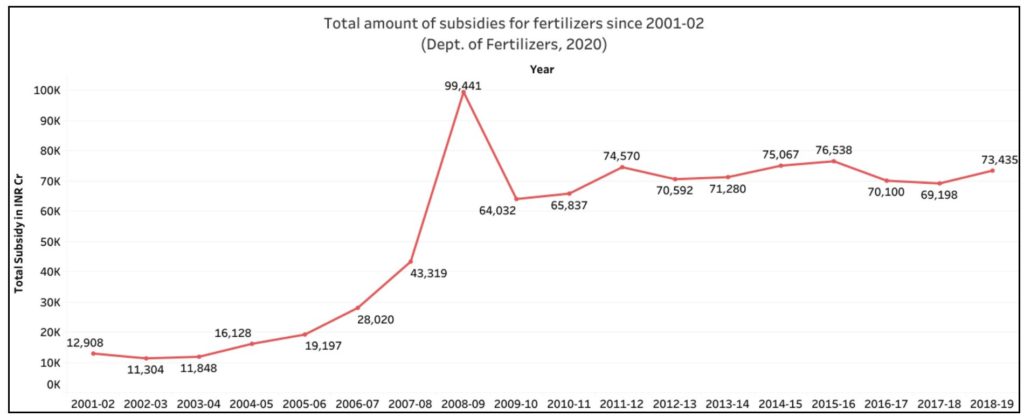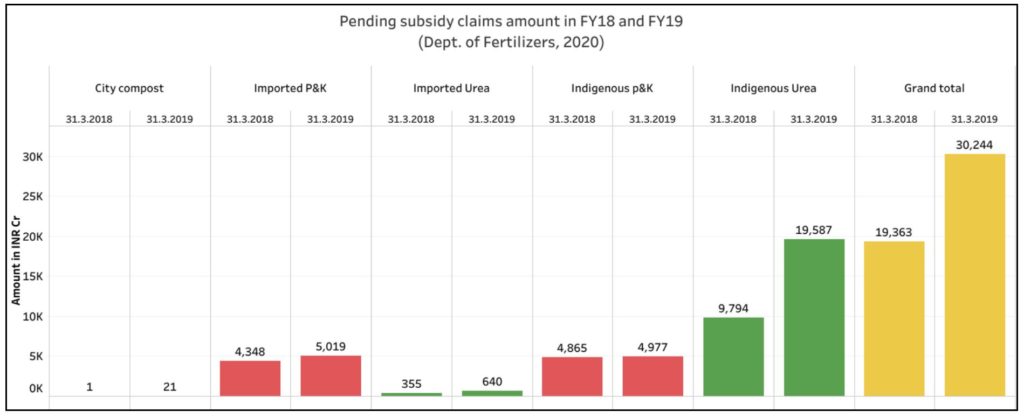A parliamentary standing committee recently submitted its report on the ‘study of system of fertilizer subsidy’ in March 2020. Among other things, the committee noted that there was a delay in settlement of subsidy dues. It advocated for DBT of fertilizer subsidy to the farmer instead of the manufacturer.
In India, Fertilizers are made available to the farmers at a subsidized and affordable price to help with increase in yield. The Department of Fertilizers has subsidized fertilizers in the range of 30% to 70% of its cost. The subsidy is passed onto companies manufacturing fertilizers so that farmers get the fertilizers at subsidized MRP. The quantum of subsidy varies with type of fertilizer like Urea, DAP etc. The subsidy is given only to those fertilizers which meet the standards laid down by the government.
The appointment of dealers and retailers who supply fertilizers to farmers is done by companies and licensing of these dealers & retailers is done by the state governments. Their availability & supply within the state is monitored by the state governments. The state governments are required to prepare a monthly estimate of the amount of fertilizers required and submit it to the Department of Agriculture which in turns coordinates with Department of Fertilizers. The Department of Fertilizers prepares the monthly supply plan after consultations with manufacturers and importers to meet the demands projected by the agriculture department.
Subsidy scheme for fertilizers was first introduced in 1977
Subsidy scheme for fertilizers was first introduced by the Indian Government in 1977 through the Retention Price Scheme (RPS) for indigenous nitrogenous fertilizer units. Subsequently, it was extended to phosphatic and other complex fertilizers and Single Super Phosphate.
In 2012, the department launched the mobile Fertilizer Monitoring System, abbreviated as mFMS, as a step to achieve better visibility and transparency in the fertilizer chain from production to receipt and sale. mFMS covers all subsidized fertilizers in India which include Urea and 21 grades of Phosphatic and Potassic fertilizers (P&K). An integrated Fertilizer Monitoring System, iFMS, began operation in 2016, with enhanced features. A total of 173 fertilizer manufacturers, 24,965 wholesalers and over 2.21 lakh retailers were registered in iFMS as of March 2020. Subsidy is not paid on sale of sub-standard fertilizers. Thus, the department records the quality certificate of all fertilizers for which subsidy is paid.
Subsidy schemes vary with type of fertilizer
Subsidy is different for different types of fertilizers. Urea is sold at a fixed MRP as determined by the Central Government. The MRP of 45 kg bag of urea is fixed at ₹ 242 per bag and the MRP of 50 kg bag of urea is ₹ 268 per bag, both exclusive of charges towards neem-coating and taxes as applicable. The subsidy given to urea manufacturers and importers is the difference between delivered cost of urea at farm gate and the net market realization by the urea units. Hence amount of subsidy payable to different urea producing plants varies from unit to unit. Likewise, the subsidy varies from plant to plant due to different energy norms. The government bears the cost of imported urea which it recovers from Fertilizers Marketing Entities or handling agencies.
Nutrition Based Subsidy Policy was introduced in 2010
In the case of P&K fertilizers, those which contain Phosphorous and Potassium compounds, a Nutrition Based Subsidy (NBS) Policy was implemented since 2010, under which a fixed rate of subsidy, in Rs per Kg basis, on each nutrient- Nitrogen (N), Phosphate (P), Potash (K) and Sulphur (S), is provided by the government each year taking into consideration international prices, exchange rate, and other factors. Secondary and micronutrients are also eligible for subsidy. There is separate additional subsidy for micronutrients namely Boron and Zinc. 20 out of 21 grades of imported P&K fertilizers are covered under the NBS scheme. Companies that have registered themselves under the scheme are eligible for availing the subsidy. Any sale above the printed MRP is punishable under the Essential Commodities Act.
City compost is a new category of fertilizers introduced in 2016
A third category of fertilizers, known as City Compost is given a fixed subsidy of ₹ 1500 per tonne. This scheme was notified in 2016 to promote the use of city compost made from garbage in cities, that would provide carbon and other primary and secondary nutrients to the soil, in addition to keeping cities clean.
The expenditure on fertilizer subsidy is increasing
Since 2001-02, there has been a continuous increase in the fertilizer subsidy expenditure. The expenditure on P&K fertilizers, both indigenous and imported was the highest in 2008-09, when the subsidy expenditure also touched the peak since in these 18 years.

While expenditure on P&K fertilizers reduced since then, the use of urea & hence the corresponding subsidy has increased. The NBS was also introduced in 2009. The shift in pricing regime was to ensure that balanced use of fertilizers. Otherwise, the farmers ended up using more fertilizers than the desired quantity.
Delay in subsidy settlement is still a problem
The estimated subsidy expenditure for 2019-20 is ₹ 83476 crores. By the end of financial year 2017-18, subsidy claims worth ₹ 19,363 crores were pending and by the end of 2018-19, an amount of ₹ 30,244 was outstanding, higher than the previous year. As per the existing policy guidelines, DBT claims should be settled within 7 working days from the date of submission of the claims. However, there is no time limit mentioned for settlement of non-DBT claims.

The price of P&K fertilizers has increased substantially which has been explained in annual report of 2018-19. This is due to increase in the price of raw materials and finished fertilizers in international market along with depreciation of Indian rupee against US Dollar.
Current system settles subsidy with manufacturer and not farmer
The present system of delivering subsidies is through Direct Benefit Transfer to the manufacturer. The system is such that a farmer identifies themselves with Aadhar biometric at the time of purchasing the fertilizer at subsidized rate. The subsidy amount is then paid to the company by the government.
Usage of fertilizers in India is much higher than desired levels
As per the standing committee report on fertilizers subsidy submitted in the Lok Sabha in March 2020, the consumption of fertilizers is much higher compared to the desired ratio. Although the desired consumption in case of NPK fertilizers is 4:2:1, the usage is (6.7):(2.4):1. It has also been reported that the consumption in states like Punjab and Haryana where agriculture is dominant, the consumption ratio was as high as (31.4): 8:1 and (27.7):(6.1):1 respectively.
It was also observed that fertilizer usage varies with the crop. Fertilizer usage in in potato cultivation, sugarcane, cotton, wheat and paddy were among the highest levels- 347.2, 192.6, 176.7 and 165.2 Kg/hectare respectively. There is excessive use of nitrogenous fertilizer as well.
Parliamentary standing committee advocates DBT on fertilizer subsidy directly to the farmer
Furthermore, the standing committee observed that manufacturers did not produce efficiently and that the government had to bear the expense of this inefficiency. As a measure to reduce the overuse by farmers and to push manufacturers to take up more efficient production methods, the standing committee has recommended that the subsidy be directly given to farmers by depositing the amount directly into their accounts on producing the necessary purchase vouchers.
The committee has further advised the government to reduce the expenditure on fertilizer subsidy by making energy norms stringent and modernizing manufacturing plants. It was also recommended that subsidy amounts should be cleared within a limited period of time to put an end to the delay in settlement.
Featured Image: Fertilizer subsidy


